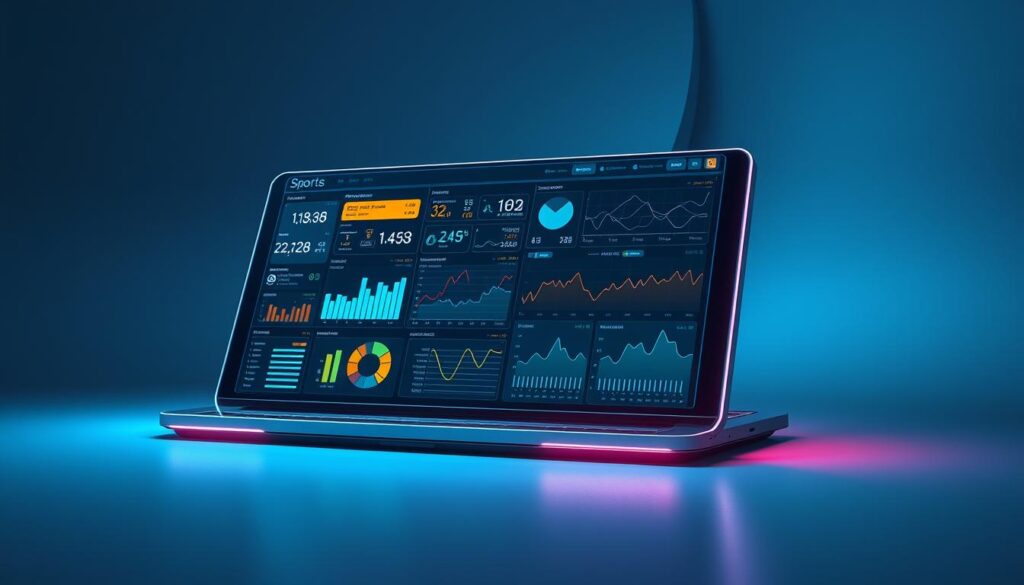As Bill Gates once said, “The advance of technology is based on making it fit in so that you don’t really even notice it, so it’s part of everyday life.” This sentiment rings true in the world of modern athletics, where digital teammates are quietly revolutionizing the game. Imagine it’s game day. The stadium roars with excitement as autonomous digital teammates work behind the scenes, reshaping sports analytics with real-time insights and transformative data analysis.
These advanced systems process vast amounts of data instantaneously, delivering actionable insights during training and competitions1. From player tracking technology in professional soccer to injury prevention in basketball, the impact is profound. The Philadelphia 76ers, for instance, experienced a significant decrease in games missed due to injury after partnering with an AI platform1.
By 2024, organizations began implementing AI experiments that yielded measurable ROI, and by 2025, deeper integration across all facets is expected2. This article explores how these technologies are transforming modern athletics, focusing on real-time feedback and data-driven decision-making. It examines the revolutionary potential to process vast amounts of data and deliver actionable insights, empowering teams and coaches to develop new strategies and refine traditional approaches.
Key Takeaways
- Digital teammates provide real-time feedback during training and competitions.
- Player tracking technology analyzes movements for immediate tactical adjustments.
- Systems detect early signs of fatigue and predict potential injuries.
- Personalized training programs are created based on unique athlete physiology.
- Detailed profiles of opposing teams assist in targeted game planning.
Introduction to AI Agents in Sports

Behind every great play, there’s a digital assistant working tirelessly to enhance performance. These advanced tools are transforming modern athletics by providing real-time insights and refining strategies. From tracking player movements to analyzing game footage, technology is becoming an indispensable part of the sports ecosystem.
During live games, these systems analyze player performance instantly. They offer detailed tactical advice, helping coaches make informed decisions. For example, tracking technology monitors every move, enabling immediate adjustments to improve outcomes3.
Training programs are also benefiting from these advancements. By monitoring athlete data, these tools create personalized plans tailored to individual needs. This approach not only boosts performance but also helps prevent injuries by identifying early signs of fatigue4.
Injury prevention is a critical area where technology shines. Systems track biometrics and external factors to predict potential risks. This allows teams to take proactive measures, ensuring players stay in top condition5.
From professional leagues to amateur teams, the impact of these tools is undeniable. They are reshaping how athletes train, compete, and recover, setting new standards for excellence in sports.
Understanding the Role of AI in Sports Analytics

The modern sports landscape is being reshaped by advanced analytics tools. These systems process vast amounts of data to provide actionable insights, helping teams refine strategies and improve performance. By leveraging computational models, organizations can make informed decisions that elevate their game.
Defining AI Agents and Their Capabilities
Computational models are designed to analyze player movement and game dynamics in real time. These tools track every detail, from speed to positioning, offering immediate feedback. Their capability to assess risk and predict outcomes helps teams stay ahead of their opponents6.
One key feature is the ability to process data at unparalleled speeds. This allows for rapid analysis of strategies and player performance. Teams can adjust tactics on the fly, ensuring they maintain a competitive level throughout the game7.
Data Collection and Processing Techniques
Wearable sensors and high-speed cameras are essential for gathering critical data. These devices monitor biometrics and movement patterns, providing a comprehensive view of athlete performance. The collected information is then filtered to eliminate noise, ensuring clear and actionable insights6.
Advanced algorithms analyze this data to identify strengths and weaknesses. They also assess the risk of injuries by monitoring workload and biomechanics. This proactive approach helps teams maintain peak performance while minimizing potential setbacks7.
By integrating these techniques, organizations can make precise decisions during games. Whether it’s adjusting strategies or predicting opponent behavior, these tools are revolutionizing how sports are played and analyzed.
Enhancing Performance Optimization through AI

Performance optimization has reached new heights with the help of cutting-edge tools. These systems provide real-time insights, enabling athletes and coaches to make smarter decisions. By analyzing data from the field, they deliver immediate feedback for continuous improvement8.
Real-Time Feedback and Adjustment
Advanced tools monitor every move on the field, offering instant feedback. This allows for quick adjustments during training and matches. For example, soccer players can refine their techniques based on real-time data9.
These systems track speed, positioning, and energy levels. Coaches use this information to optimize strategies and enhance performance. The result is a more dynamic and responsive approach to athletics8.
Personalized Training Programs and Insights
Personalized training programs are tailored to each athlete’s unique needs. By analyzing performance trends, these tools create customized plans. This ensures that every session is effective and efficient9.
Minute variations in technique and movement are measured. These insights help athletes refine their skills and avoid common pitfalls. The feedback loop ensures continuous improvement and system refinement10.
With these tools, athletes can achieve their full potential. The integration of real-time feedback and personalized programs is transforming the way they train and compete.
Injury Prevention and Recovery with AI

Injury prevention has become a cornerstone of modern athletic success. Advanced tools analyze biomechanical data to identify risky movement patterns before they lead to injuries. These systems use sophisticated algorithms to monitor player performance, flagging subtle anomalies that could escalate into serious issues11.
Real-time data collection plays a crucial role in early detection. Wearable sensors track metrics like stress levels and recovery rates, providing actionable insights. This proactive approach helps teams adjust training intensity or recommend immediate rest, minimizing long-term damage12.
Predictive Injury Analytics
Predictive analytics focus on identifying patterns that increase injury risk. By analyzing historical data and current trends, these tools forecast potential issues. For example, subtle changes in biomechanics can signal the need for intervention11.
Machine learning models process vast datasets to detect abnormalities. This allows coaches to make informed decisions, ensuring athletes stay healthy. The result is a significant reduction in downtime and improved career longevity12.
Customized Rehabilitation Strategies
Recovery is just as important as prevention. Tailored programs are designed based on individual needs, ensuring a faster and more effective healing process. These recommendations are backed by data, offering personalized training and rest schedules11.
Advanced systems monitor progress, adjusting plans as needed. This dynamic approach ensures athletes return to peak condition safely. Teams benefit from optimized performance and reduced injury rates, giving them a competitive edge12.
For more insights on how technology is transforming injury prediction, explore the latest advancements in sports science.
Tactical Analysis and Strategic Game Planning
Strategic planning in sports has evolved with the integration of advanced tools, offering teams a competitive edge. These systems analyze historical and live data to guide pre-game preparations and enable in-game tactical adjustments. By leveraging real-time insights, coaches can refine strategies and optimize performance13.
Pre-Game Tactical Preparation
Before the game begins, tools analyze historical data and opponent patterns. This helps coaches identify strengths and weaknesses, creating targeted strategies. For example, detailed profiles of opposing teams assist in game planning, ensuring teams are well-prepared14.
These systems also simulate game scenarios, allowing teams to practice specific plays. This approach enhances tactical effectiveness and builds confidence. By focusing on player movement and technique, teams can anticipate challenges and adapt accordingly15.
In-Game Adjustments and Live Feedback
During the match, real-time analytics inform decisions and adjustments. Tools monitor player movement and technique, offering immediate feedback. This allows coaches to refine strategies on the fly, ensuring optimal performance13.
Live feedback also enhances the overall experience for both coaches and athletes. By continuously analyzing data, these systems help teams stay ahead of their opponents. This dynamic approach ensures that strategies remain effective throughout the game14.
Injury prevention is another critical aspect. By monitoring workload and biomechanics, tools identify early signs of fatigue. This ensures players perform safely while maximizing tactical effectiveness15.
AI Agents in Sports: Enhancing Performance and Strategy
The fusion of cutting-edge technology with athletic strategy is reshaping how teams approach competition. These innovations provide a significant advantage by offering real-time insights and actionable data. From tactical planning to in-game adjustments, the integration of advanced tools is transforming the sports landscape11.
Integration of Advanced Technologies
Modern tools are redefining how teams prepare for high-stakes scenarios. For example, platforms like SmythOS analyze player movements and predict outcomes with remarkable accuracy. This allows coaches to refine strategies before a match even begins16.
During live games, these systems monitor every detail, from player positioning to energy levels. This real-time feedback enables immediate adjustments, ensuring teams stay ahead in competition. The result is a more dynamic and responsive approach to athletics17.
Empowering Coaches and Teams through Data-Driven Decisions
Data-driven insights are empowering coaches to make smarter decisions. By analyzing historical and live data, these tools provide a clear picture of strengths and weaknesses. This helps teams create targeted strategies that maximize their advantage11.
For instance, Liverpool FC uses advanced analytics to develop tactics based on player performance. This innovation has led to more effective game plans and improved results16.
As technology continues to evolve, its potential to transform traditional coaching methods grows. The ability to merge real-time intelligence with established frameworks ensures teams remain competitive in an ever-changing landscape17.
Conclusion
The integration of advanced technologies has revolutionized how teams approach competition, offering unprecedented insights and precision. These tools provide real-time data, enabling coaches to refine strategies with higher accuracy and efficiency18.
From injury prevention to tactical analysis, the impact is profound. Systems predict potential risks and create personalized training plans, ensuring athletes perform at their best19. This proactive approach minimizes downtime and maximizes performance.
Looking ahead, the potential for innovation is immense. As technology evolves, it will continue to transform traditional methods, offering new ways to enhance game plans and decision-making. Teams that embrace these tools gain a significant competitive edge.
For more insights on how technology is reshaping athletics, explore the latest advancements in AI in sports. The future of competition lies in leveraging data-driven tools to achieve excellence.
FAQ
How do advanced technologies improve athlete performance?
What role does data play in injury prevention?
How do coaches use tactical analysis for game planning?
Can technology enhance decision-making during competition?
What are the benefits of personalized training programs?
How does predictive analytics improve team strategy?
What tools are used for real-time feedback during training?
How does technology support recovery and rehabilitation?
Source Links
- SmythOS – Autonomous Agents in Sports Analytics: Enhancing Performance Through Advanced Data Insights
- Op-Ed: AI Takes the Field — How Technology Will Revolutionize Sports in 2025
- How AI is Transforming the Sports Industry in 2024?
- AI in Sports: Applications and Use Cases
- AI & Sports Analytics- Game Strategy, Player Development and Scouting
- No title found
- AI in Sports: Transforming the Game for Players and Fans
- AI in Sports Analytics: Deep Learning for Better Performance
- “AI Agents In Sports: Analyzing Performance And Strategy” – AiWeb.Academy
- AI In Sports: Use Cases, Implementation, Applications and Examples
- AI in Sports— The Future of Sports Industries
- Welcome to the Agentic AI Era: The Next Game-Changer for Sports Properties
- AI in Sports: Applications and Real World Use Cases – Topdevelopers.co
- Generative AI’s Impact on Sports: Advancing Performance, Engagement, and Insight
- AI in Sports – How is AI Transforming the Sports Industry?
- Artificial intelligence — The MVP for personalizing sports
- AI In Sports Strategy Analysis Trends | Restackio
- AI in Sports: Revolutionizing the Game
- How AI is Transforming the Sports Industry In 2025







